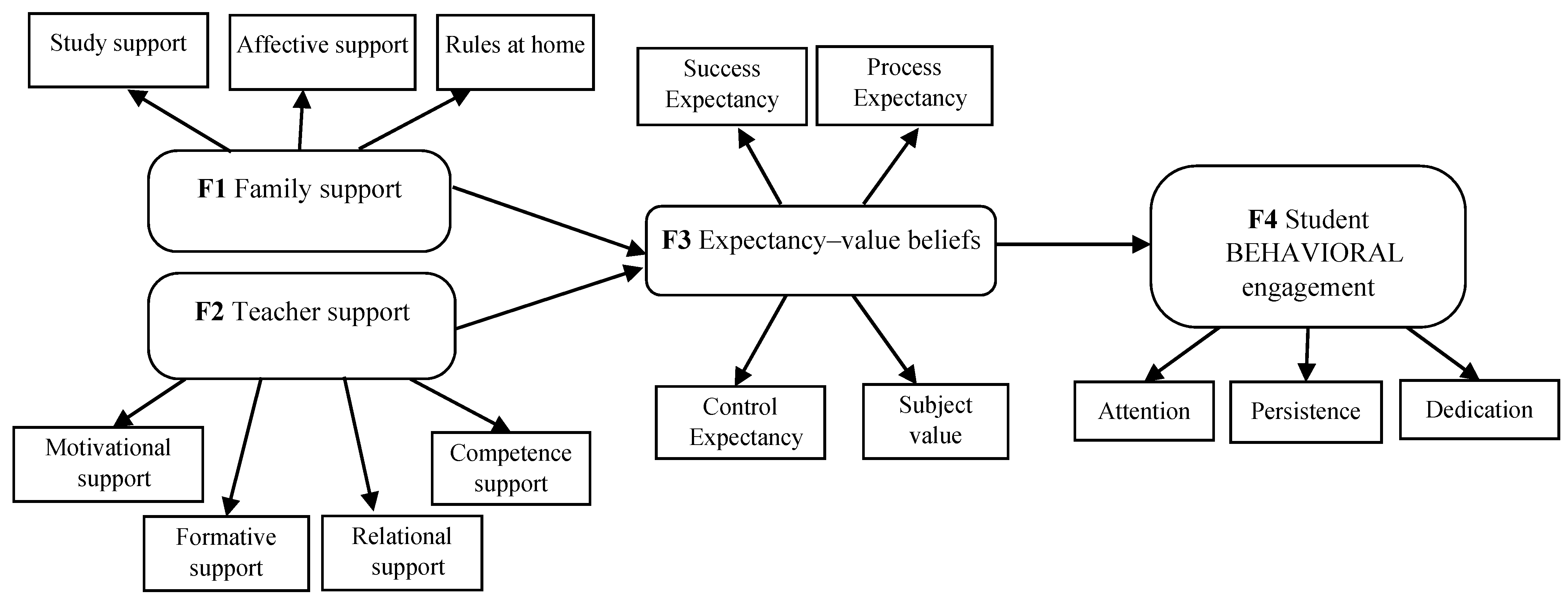Influence of Teacher and Family Support on University Student Motivation and Engagement
Abstract
1. Introduction
1.1. Stage I: Students’ Perception of Support Resources: Teacher and Family Support
1.2. Stage II: Intention to Learn Measured by Expectancy–Value Beliefs and Achievement Goals
1.3. Stage III: Student Engagement
1.4. Relations among Variables
1.4.1. Support Resources and Expectancy–Value Beliefs and Student Engagement
1.4.2. Support Resources and Achievement Goals and Student Engagement
1.5. Objectives and Hypotheses
2. Method
2.1. Participants and Procedure
2.2. Measures
2.3. Statistical Analyses
3. Results
3.1. Descriptive Statistics and Internal Consistency of Scales
3.2. Correlation between Variables
3.3. Structural Equation Modeling
4. Discussion
4.1. Conclusions
4.2. Practical Implications
4.3. Limitations and Suggestions for Future Research
Author Contributions
Funding
Institutional Review Board Statement
Informed Consent Statement
Data Availability Statement
Conflicts of Interest
References
- Maleki, C.; Demaray, M. What type of support do they need? Investigating student adjustment as related to emotional, informational, appraisal, and instrumental support. Sch. Psychol. Q. 2003, 18, 231–252. [Google Scholar] [CrossRef]
- Katz, I.; Kaplan, A.; Gueta, G. Students’ needs, teachers’ support, and motivation for doing homework: A cross-sectional study. J. Exp. Educ. 2009, 78, 246–267. [Google Scholar] [CrossRef]
- Reyes, M.R.; Brackett, M.A.; Rivers, S.E.; White, M.; Salovey, P. Classroom emotional climate, student engagement, and academic achievement. J. Educ. Psychol. 2012, 104, 700–712. [Google Scholar] [CrossRef]
- Sharma, G. Teacher support as determinant of academic achievement. J. Educ. Res. 2016, 2, 1–9. [Google Scholar]
- Jelas, Z.M.; Azman, N.; Zulnaidi, H.; Ahmad, N.A. Learning support and academic achievement among Malaysian adolescents: The mediating role of student engagement. Learn. Environ. Res. 2016, 19, 221–240. [Google Scholar] [CrossRef]
- Simons-Morton, B.; Crump, A. The association of parental involvement and social competence with school adjustment and engagement among sixth graders. J. Sch. Health 2003, 73, 121–126. [Google Scholar] [CrossRef] [PubMed]
- Doménech-Betoret, F. Testing an instructional model in a university educational setting from the student’s perspective. Learn. Instr. 2016, 16, 450–466. [Google Scholar] [CrossRef]
- Doménech-Betoret, F. An instructional model for guiding reflection and research in the classroom: The educational situation quality model. Electron. J. Res. Educ. Psychol. 2013, 11, 239–260. [Google Scholar]
- Doménech-Betoret, F. The Educational Situation Quality Model: Recent Advances. Front. Psychol. 2018, 9, 328. [Google Scholar] [CrossRef] [PubMed]
- Doménech-Betoret, F.; Gómez-Artiga, A.; Abellán-Roselló, L.; Rocabert-Beút, E. MOCSE Centered on Students: Validation of Learning Demands and Teacher Support Scales. Front. Psychol. 2020, 11, 582926. [Google Scholar] [CrossRef] [PubMed]
- Heckhausen, H.; Kuhl, J. From wishes to action: The dead ends and short cuts on the long way to action. In Goal-Directed Behaviour: The Concept of Action in Psychology; Frese, M., Sabini, J., Eds.; Lawrence Erlbaum: Hillsdale, NJ, USA, 1985; pp. 134–160. [Google Scholar]
- Demerouti, E.; Bakker, A.B.; Nachreiner, F.; Schaufeli, W.B. The job demands resources model of burnout. J. Appl. Psychol. 2001, 86, 499–512. [Google Scholar] [CrossRef]
- Eccles, J.S.; Wigfield, A. Motivational beliefs, values, and goals. Annu. Rev. Psychol. 2002, 53, 109–132. [Google Scholar] [CrossRef] [PubMed]
- Ames, C. Classrooms: Goals, structures, and student motivation. J. Educ. Psychol. 1992, 84, 261–271. [Google Scholar] [CrossRef]
- Dweck, C.S.; Leggett, E.L. A social-cognitive approach to motivation and personality. Psychol. Rev. 1988, 95, 256–273. [Google Scholar] [CrossRef]
- Nicholls, J. The Competitive Ethos and Democratic Education; Harvard University Press: Cambridge, MA, USA, 1989. [Google Scholar]
- Wigfield, A.; Eccles, J.S. Expectancy-value theory of achievement motivation. Contemp. Educ. Psychol. 2000, 25, 68–81. [Google Scholar] [CrossRef] [PubMed]
- Doménech-Betoret, F.; Abellán-Roselló, L. Guía Práctica para Mejorar la Motivación del Alumnado de Educación Secundaria y Formación Profesional; Col.lecció Educació; Publicaciones de la Universitat Jaume I: Castellón, Spain, 2017. [Google Scholar]
- Doménech-Betoret, F.; Gómez-Artiga, A.; Abellán-Roselló, L. The Educational Situation Quality Model: A New Tool to Explain and Improve Academic Achievement and Course Satisfaction. Front. Psychol. 2019, 10, 1692. [Google Scholar] [CrossRef]
- King, R.B.; McInerney, D.M. The work avoidance goal construct: Examining its structure, antecedents, and consequences. Contemp. Educ. Psychol. 2014, 39, 42–58. [Google Scholar] [CrossRef]
- Wellborn, J.G.; Connell, J.P. Research Assessment Package for Schools: Manual for Elementary and Middle School Assessments; University of Rochester: Rochester, NY, USA, 1998. [Google Scholar]
- Spera, C. A review of the relationship among parenting practices, parenting styles, and adolescent school achievement. Educ. Psychol. Rev. 2005, 17, 120–146. [Google Scholar] [CrossRef]
- Bempechat, J.; Shernoff, D.J. Parental Influences on Achievement Motivation and Student Engagement. In Handbook of Research on Student, Engagement; Christenson, S.L., Reschly, A.L., Wylie, C., Eds.; Springer Science + Business Media: Boston, MA, USA, 2012; pp. 315–342. [Google Scholar] [CrossRef]
- Chohan, B.I.; Khan, R.M. Impact of Parental Support on the Academic Performance and Self-Concept of the Student. J. Res. Reflect. Educ. 2010, 4, 14–26. [Google Scholar]
- Simpkins, S.D.; Price, C.D.; Garcia, K. Parental Support and High School Students’ Motivation in Biology, Chemistry, and Physics: Understanding differences a mong latino and caucasian boys and girls. J. Res. Sci. Teach. 2015, 52, 1386–1407. [Google Scholar] [CrossRef]
- Grolnick, W.S.; Friendly, R.W.; Bellas, V.M. Parenting and children’s motivation at school. In Handbook of Motivation at School; Wentzel, K.R., Wigfield, A., Eds.; Routledge: New York, NY, USA, 2009; pp. 279–300. [Google Scholar]
- Chen, B.-B.; Wiium, N.; Dimitrova, R.; Chen, N. The Relationships between Family, School and Community Support and Boundaries and Student Engagement among Chinese Adolescents. Curr. Psychol. 2019, 38, 705–714. [Google Scholar] [CrossRef]
- Bandura, A. Social Foundations of Thought and Action: A Social Cognitive Theory; Prentice-Hall: Englewood Cliffs, NJ, USA, 1986. [Google Scholar]
- Liem, A.D.; Lau, S.; Nie, Y. The role of self-efficacy, task value, and achievement goals in predicting learning strategies, task disengagement, peer relationship, and achievement outcome. Contemp. Educ. Psychol. 2008, 33, 486–512. [Google Scholar] [CrossRef]
- Pintrich, P.R. The dynamic interplay of student motivation and cognition in the college classroom. In Advances in Motivation and Achievement; Pintrich, P.R., Maher, M.L., Eds.; JAI Press: Greenwich, CT, USA, 1989; Volume 6. [Google Scholar]
- Pintrich, P.R.; de Groot, E.V. Motivational and self-regulated learning components of classroom academic performance. J. Educ. Psychol. 1990, 82, 33–40. [Google Scholar] [CrossRef]
- Martín, F.; Romero, M.E. Influencia de las expectativas en el rendimiento académico. Aula Abierta 2003, 81, 99–110. [Google Scholar]
- Valle, A.; Regueiro, B.; Rodríguez, S.; Piñeiro, I.; Freire, C.; Ferradás, M.; Suárez, M. Perfiles motivacionales como combinación de expectativas de autoeficacia y metas académicas en estudiantes universitarios. Eur. J. Educ. Psychol. 2015, 8, 1–8. [Google Scholar] [CrossRef]
- Eccles, J. Who am I and what am I going to do with my life? Personal and collective identities as motivators of action. Educ. Psychol. 2009, 44, 78–89. [Google Scholar] [CrossRef]
- Skaalvik, E.M. Self-enchancing and self-defeating ego orientation: Relations with task and avoidance orientation, achievement, self-perceptions, and anxiety. J. Educ. Psychol. 1997, 89, 71–81. [Google Scholar] [CrossRef]
- Midgley, C.; Maehr, M.; Hruda, L.; Anderman, E.; Anderman, L.; Freeman, K.; Urdan, T. Manual for the Patterns of Adaptative Learning Scales (PALS); The University of Michigan, School of Education: Ann Arbor, MI, USA, 2000. [Google Scholar]
- Maehr, M.L.; Zusho, A. Achievement goal theory: The past, present, and future. In Handbook of Motivation at School; Wentzel, K., Wigfield, A., Eds.; Routledge: New York, NY, USA, 2009; pp. 77–104. [Google Scholar]
- Alonso Tapia, J. Motivación y Aprendizaje en el Aula; Aula XXI Santillana: Madrid, Spain, 2002. [Google Scholar]
- Schaufeli, W.B. The measurement of work engagement. In Research Methods in Occupational Health Psychology: Measurement, Design, and Data Analysis; Sinclair, R.R., Wang, M., Tetrick, L.E., Eds.; Routledge/Taylor & Francis Group: London, UK, 2013; pp. 138–153. [Google Scholar]
- Fredricks, J.A.; Blumenfeld, P.C.; Paris, A.H. School engagement: Potential of the concept, state of the evidence. Rev. Educ. Res. 2004, 74, 59–109. [Google Scholar] [CrossRef]
- Lam, S.F.; Jimerson, S.; Wong, B.P.H.; Kikas, E.; Shin, H.; Veiga, F.H.; Hatzichristou, C.; Polychroni, F.; Cefai, C.; Negovan, V.; et al. Understanding and measuring student engagement in school: The results of an international study from 12 countries. Sch. Psychol. Q. 2014, 29, 213–232. [Google Scholar] [CrossRef] [PubMed]
- Wang, M.T.; Degol, J. Staying engaged: Knowledge and research needs in student engagement. Child Dev. Perspect. 2014, 8, 137–143. [Google Scholar] [CrossRef] [PubMed]
- Metallidou, P.; Vlachou, A. Motivational beliefs, cognitive engagement, and achievement in language and mathematics in elementary school children. Int. J. Psychol. 2007, 42, 2–15. [Google Scholar] [CrossRef]
- Davis, H.A.; Chang, M.-L.; Andrzejewski, C.E.; Poirier, R.R. Examining relational engagement across the transition to high schools in three US high schools reformed to improve relationship quality. Learn. Environ. Res. 2014, 17, 263–286. [Google Scholar] [CrossRef]
- Handelsman, M.M.; Briggs, W.L.; Sullivan, N.; Towler, A. A measure of college student course engagement. J. Educ. Res. 2005, 98, 184–191. [Google Scholar] [CrossRef]
- Brewster, A.B.; Bowen, G.L. Teacher support and the school engagement of Latino middle and high school students at risk of school failure. Child Adolesc. Soc. Work J. 2004, 21, 47–67. [Google Scholar] [CrossRef]
- Garcia-Reid, P.; Reid, R.J.; Peterson, N.A. School engagement among Latino youth in an urban middle school context: Valuing the role of social support. Educ. Urban Soc. 2005, 37, 257–275. [Google Scholar] [CrossRef]
- Garcia-Reid, P.; Hamme, C.; Reid, R.J. Parent and Teacher Support Among Latino Immigrant Youth: Effects on School Engagement and School Trouble Avoidance. Educ. Urban Soc. 2015, 47, 328–343. [Google Scholar] [CrossRef]
- Lam, S.-F.; Jimerson, S.; Shin, H.; Cefai, C.; Veiga, F.H.; Hatzichristou, C.; Polychroni, F.; Kikas, E.; Wong, B.P.; Stanculescu, E.; et al. Cultural universality and specificity of student engagement in school: The results of an international study from 12 countries. Br. J. Educ. Psychol. 2016, 50, 77–94. [Google Scholar] [CrossRef] [PubMed]
- Perry, J.C.; Liu, X.; Pabian, Y. School Engagement as a Mediator of Academic Performance among Urban Youth: The Role of Career Preparation, Parental Career Support, and Teacher Support. Couns. Psychol. 2010, 38, 269–295. [Google Scholar] [CrossRef]
- Wang, M.T.; Eccles, J.S. Social support matters: Longitudinal effects of social support on three dimensions of school engagement from middle to high school. Child Dev. 2012, 83, 877–895. [Google Scholar] [CrossRef] [PubMed]
- Wentzel, K. Social relationships and motivation in middle school: The role of parents, teachers, and peers. J. Educ. Psychol. 1998, 90, 202–209. [Google Scholar] [CrossRef]
- Woolley, M.E.; Bowen, G.L. In the context of risk: Supportive adults and the school engagement of middle school students. Fam. Relat. 2007, 56, 92–104. [Google Scholar] [CrossRef]
- Veiga, F.H.; Robu, V.; Conboy, J.; Ortiz, A.; Carvalho, C.; Galvao, D. Student’s engagement in school and family variables: A literature review. Estud. Psicol. 2016, 33, 2. [Google Scholar] [CrossRef][Green Version]
- Rodríguez, S.; Piñeiro, I.; Gómez, M.L.; Regueiro, B.; Estévez, I.; Valle, A. An explanatory model of maths achievement: Perceived parental involvement and academic motivation. Psicothema 2017, 29, 184–190. [Google Scholar] [PubMed]
- Dietrich, J.; Dicke, A.L.; Kracke, B.; Noack, P. Teacher support and its influence on students’ intrinsic value and effort: Dimensional comparison effects across subjects. Learn. Instr. 2015, 39, 45–54. [Google Scholar] [CrossRef]
- Ruzek, E.A.; Hafen, C.A.; Allen, J.P.; Gregory, A.; Mikami, A.Y.; Pianta, R. How teacher emotional support motivates students: The mediating roles of perceived peer relatedness, autonomy support, and competence. Learn. Instr. 2016, 42, 95–103. [Google Scholar] [CrossRef] [PubMed]
- Fan, W. Social influences, school motivación and gender differences: An application of expectancy-value theory. Educ. Psychol. 2011, 31, 157–175. [Google Scholar] [CrossRef]
- Fielding-Wells, J.; O’Brien, M.; Makar, K. Using expectancy-value theory to explore aspects of motivation and engagement in inquiry-based learning in primary mathematics. Math. Educ. Res. J. 2017, 29, 237–254. [Google Scholar] [CrossRef]
- Yli-Piipari, S.; Kokkonen, J. An Application of the Expentancy-Value Model to Understand Adolescents’ Performance and Engagement in Physical Education. J. Teach. Phys. Educ. 2014, 33, 250–268. [Google Scholar] [CrossRef]
- Fonteyne, L.; Eelbode, A.; Lanszweert, I.; Roels, E.; Schelfhout, S.; Duych, W.; De-Fruyt, F. Career goal engagement following negative feedback: Influence of expectancy-value and perceived feedback accuracy. Int. J. Educ. Vocat. Guid. 2018, 18, 165–180. [Google Scholar] [CrossRef]
- Gao, Z.; Xiang, P. College Studens’ Motivation Toward Weight Training: An Application of Expentancy-Value Model. J. Teach. Phys. Educ. 2008, 27, 399–415. [Google Scholar] [CrossRef]
- Gasco, J.; Villarroel, J.D. The Motivation of Secondary School Students in Mathematical Word Problem Solving. Electron. J. Res. Educ. Psychol. 2014, 12, 83–106. [Google Scholar] [CrossRef]
- Guo, J.; Marsh, H.W.; Morin, A.J.S.; Parker, P.D.; Kaur, G. Directionality of the Associations of High School Expectancy-Value, Aspirations, and Attainment: A Longitudinal Study. Am. Educ. Res. J. 2015, 52, 371–402. [Google Scholar] [CrossRef]
- Wentzel, K.R.; Shannon, A.B.; Rusell, L.; Looney, L.B. Social supports from teachers and peers as predictors of academic and social motivation. Contemp. Educ. Psychol. 2010, 35, 193–202. [Google Scholar] [CrossRef]
- Senko, C.; Dawson, D. Performance-Approach Goal Effects Depend on How They Are Defined: Meta- Analytic Evidence from Multiple Educational Outcomes. J. Educ. Psychol. 2017, 109, 574–598. [Google Scholar] [CrossRef]
- Martin, A.J.; Leim, G.A. Academic Personal Bests (PBs), Engagement, and Achievement: A Cross-lagged Panel Analysis. Learn. Individ. Differ. 2010, 20, 265–270. [Google Scholar] [CrossRef]
- Martin, A.J.; Elliot, A.J. The role of personal best (PB) and dichotomous achievement goals in students’ academic motivation and engagement: A longitudinal investigation. Educ. Psychol. 2016, 36, 1285–1302. [Google Scholar] [CrossRef]
- Wang, C.; Shim, S.S.; Wolters, C.A. Achievement goals, motivational self-talk, and academic engagement among Chinese students. Asia Pac. Educ. Rev. 2017, 18, 295–307. [Google Scholar] [CrossRef]
- Sommet, N.; Andrew, J.E. Achievement Goals, Reasons for Goal Pursuit, and Achievement Goal Complexes as Predictors of Beneficial Outcomes: Is the Influence of Goals Reducible to Reasons? J. Educ. Psychol. 2017, 109, 1141–1162. [Google Scholar] [CrossRef]
- Sommet, N.; Nguyen, D.; Fahrni, K.; Jobin, M.; Nguyen, H.-P.; Sehaqui, H.; Butera, F. When and why performance goals predict exploitation behaviors: An achievement goal complex analysis of the selection function of assessment. Motiv. Emot. 2019, 43, 266–284. [Google Scholar] [CrossRef]
- Bentler, P.M. EQS 6 Structural Equations Program Manual; Multivarite Sotware Inc.: Ecino, CA, USA, 2006. [Google Scholar]
- Doménech-Betorét, F.; Gómez-Artiga, A.; Lloret-Segura, S. Personal variables, motivation and avoidance learning strategies in undergraduate students. Learn. Individ. Differ. 2014, 35, 122–129. [Google Scholar] [CrossRef]
- Satorra, A.; Bentler, P.M. Scaling Corrections for Chi-Square Statistics in Covariancestructure Analysis; American Statistical Association: Alexandria, VA, USA, 1988; pp. 308–313. [Google Scholar]
- Bentler, P.M. Comparative fit indexes in structural models. Psychol. Bull. 1990, 107, 238–246. [Google Scholar] [CrossRef] [PubMed]
- Hoyle, R.H. The Structural Equation Modeling Approach: Basic Concepts and Fundamental Issues. In Structural Equation Modeling: Concepts, Issues, and Applications; Hoyle, R.H., Ed.; Sage Publications, Inc.: Thousand Oaks, CA, USA, 1995; pp. 1–15. [Google Scholar]
- Hu, L.-T.; Bentler, P.M. Cutoff criteria for fit indexes in covariance structure analysis: Conventional criteria versus new alternatives. Struct. Equ. Model. 1999, 6, 1–55. [Google Scholar] [CrossRef]
- Browne, M.W.; Cudeck, R. Alternative Ways of Assessing Model Fit. In Testing Structural Equation Models; Bollen, K.A., Long, J.S., Eds.; Sage: Newbury Park, CA, USA, 1993; pp. 136–162. [Google Scholar]
- Dörnyei, Z. Motivation in action: Towards a process-oriented conceptualization of student motivation. Br. J. Educ. Psychol. 2000, 70, 519–538. [Google Scholar] [CrossRef] [PubMed]
- Filsecker, M.; Kerres, M. Engagement as a Volitional Construct: A Framework for Evidence-Based Research on Educational Games. Simul. Gaming 2014, 45, 450–470. [Google Scholar] [CrossRef]
- Furrer, C.; Skinner, E. Sentido de afinidad como factor en el compromiso y el desempeño académico de los niños. Rev. Psicol. Educ. 2003, 95, 148–162. [Google Scholar] [CrossRef]
- Marchant, G.J.; Paulson, S.E.; Rothlisberg, B.A. Relations of middle school students’ perceptions of family and school contexts with academic achievement. Psychol. Sch. 2001, 38, 505–519. [Google Scholar] [CrossRef]
- Hulleman, C.S.; Schrager, S.M.; Bodmann, S.W.; Harackiewicz, J.M. A meta-analytic review of achievement goal measures: Different labels for the same constructs or different constructs with similar labels? Psychol. Bull. 2010, 136, 422–449. [Google Scholar] [CrossRef] [PubMed]
- Lin-Siegler, X.; Dweck, C.S.; Cohen, L. Instructional interventions that motivate classroom learning. J. Educ. Psychol. 2016, 108, 295–299. [Google Scholar] [CrossRef]
- Wilson, T.D.; Buttrick, N.R. New directions in social psychological interventions to improve academic achievement. J. Educ. Psychol. 2016, 108, 392–396. [Google Scholar] [CrossRef]
- Soenens, B.; Vansteenkiste, M. Antecedents and outcomes of selfdetermination in three life domains: The role of parents’ and teachers’ autonomy support. J. Youth Adolesc. 2005, 34, 589–604. [Google Scholar] [CrossRef]
- Deci, E.L.; Ryan, R.M. The “what” and “why” of goal pursuit: Human needs and the self-determination of behavior. Psychol. Inq. 2000, 11, 227–268. [Google Scholar] [CrossRef]
- Deci, E.; Ryan, R.M. Overview of Self-Determination Theory: An organismic dialectical perspective. In Handbook of Theories of Social Psychology; Paul, A.M., Van Lange, A., Kruglanski, W., Tory Higinss, E., Eds.; The University of Rochester Press: Rochester, NY, USA; Sage: Thousand Oaks, CA, USA, 2012; Volume 1, pp. 416–431. [Google Scholar]
- Reis, H.; Sheldon, K.; Gable, S.; Roscoe, J.; Ryan, R. Daily well-being: The role of autonomy, competence and relatedness. Personal. Soc. Psychol. Bull. 2000, 26, 419–435. [Google Scholar] [CrossRef]
- Jiang, X.; Shi, D.; Topps, A.K.; Archer, C.M. From Family Support to Goal-Directed Behaviors: Examining the Mediating Role of Cognitive Well-Being Factors. J. Happiness Stud. 2019, 21, 1015–1035. [Google Scholar] [CrossRef]






| Scales | Factors | Items (n) | M | S.D. | Variance | Cronbach’s α |
|---|---|---|---|---|---|---|
| (Minimum = 1; Maximum = 6) | ||||||
| Family support | 3 | 12 | 77.28 | |||
| F1: Affective support | 5 | 4.92 | 1.20 | 35.79 | 0.94 | |
| F2: Study support | 3 | 4.84 | 1.24 | 21.44 | 0.90 | |
| F3: Rules at home | 4 | 4.74 | 1.07 | 20.04 | 0.77 | |
| Teacher support | 4 | 21 | 69.36 | |||
| F1: Motivational support | 6 | 4.20 | 0.99 | 20.69 | 0.91 | |
| F2: Relational support | 6 | 4.94 | 0.78 | 18.95 | 0.90 | |
| F3: Self-competence support | 5 | 4.80 | 0.85 | 18.15 | 0.91 | |
| F4: Formative evaluation (teacher feedback) | 4 | 4.52 | 0.76 | 11.57 | 0.75 | |
| Expectancy–value beliefs | 4 | 21 | 72.40 | |||
| F1: Success expectancy | 10 | 4.17 | 0.76 | 30.75 | 0.94 | |
| F2: Subject value | 4 | 3.34 | 1.01 | 15.02 | 0.82 | |
| F3: Control expectancy | 4 | 5.00 | 0.75 | 14.52 | 0.87 | |
| F4: Process expectancy: Feeling good | 3 | 3.96 | 1.19 | 12.11 | 0.93 | |
| Achievement goals | 5 | 22 | 82.04 | |||
| F1: Performance-Avoiding goal | 5 | 2.02 | 1.26 | 20.22 | 0.96 | |
| F2: Mastery goal | 5 | 4.95 | 1.02 | 20.23 | 0.95 | |
| F3: Performance goal | 5 | 3.12 | 1.35 | 19.10 | 0.96 | |
| F4: Avoiding effort goal | 4 | 2.25 | 1.05 | 13.62 | 0.88 | |
| F5: Self-worth goal | 3 | 4.17 | 0.98 | 8.56 | 0.70 | |
| Behavioral engagement | 3 | 15 | 76.46 | |||
| F1: Attention | 6 | 4.58 | 0.90 | 28.02 | 0.92 | |
| F2: Persistence | 5 | 3.71 | 1.23 | 27.08 | 0.94 | |
| F3: Dedication | 4 | 4.20 | 1.04 | 21.36 | 0.90 | |
| Family support F1: Affective support: “Mis padres me transmiten constantemente su afecto y cariño” [“My parents always make known their affection and love for me”] F2: Study support: “Mis padres suelen preguntarme por mis estudios” [“My parents tend to ask me about my studies”] F3: Rules at home: “En mi casa no existen las normas, cada uno hace lo que quiere y cuando quiere” [“We have no rules at home. Everyone does whatever they want, when they want”] (Reversed code) Teacher support F1: Motivational support: “Desde el principio, el profesor se esforzó por despertar nuestra curiosidad e interés por esta materia” [“From the beginning, the teacher made an effort to awaken our curiosity and interest in this subject”] F2: Relational support: “Por lo que he visto estos primeros días de clase, creo que el profesor/a será una persona cercana” [“From what I have seen on these first days of class, I think the teacher will be close”] F3: Self-competence support: “Desde el principio, el profesor nos ha trasmitido la idea de que todos estamos capacitsdos para superar esta materia si nos lo proponemos” [“From the beginning, the teacher has conveyed us the idea that we are all qualifyied to overcome this matter if we propose it”] F4: Formative evaluation (teacher feedback): “El sistema de evaluación torga mucha importancia al trabajo continuado del estudiante y al feedback del profesor” [“The evaluation system attaches much importance to students’ continued work and the teacher’s feedback”] Expectancy–value beliefs F1: Success expectancy: “¿Piensas que serás capaz de obtener buenas notas en esta materia?” [“Do you think you will be able to obtain good marks for this subject?”] F2: Subject value: “¿Cómo es de útil esta materia para tí?” [“How useful is this subject for you?”] (usefulness) F3: Control expectancy: “¿En qué medida crees que influirá tu dedicación a la asignatura en tu nota final?” [“To what extent do you think that your dedication to the subject will influence your final mark?”] F4: Process expectancy: Feeling good: “¿Crees que te sentirás bien en clase con este profesor/a, de aquí a final de curso?” [“Do you think you will feel comfortable with this teacher from this point onwards until the end of the course?”] Achievement goals F1: Performance-avoidance goal: “Mi objetivo en esta asignatura es evitar que mis compañeros y el profesor/a piensen que soy un tonto” [“My goal in this subject is to avoid my classmates and my teacher thinking I’m a fool”] F2: Mastery goal: “Mi objetivo en esta asignatura es aprender todo lo que pueda” [“My goal in this subject is to learn as much as possible”] F3: Performance goal: “Mi objetivo en esta asignatura es demostrar a mis compañeros/as y al profesor/a que soy bueno en esta materia” [“My goal in this subject is to show my classmates and my teacher that I’m good in this subject”] F4: Effort-avoidance goal: “Mi objetivo en esta asignatura es superarla con el mínimo esfuerzo” [“My goal in this subject is to pass it by making the minimum effort”]. F5: Self-worth goal: “Mi objetivo en esta asignatura es experimentar el orgullo que sigue al éxito” [“My goal in this subject is to feel the pride that comes with success”] Behavioral engagement F1: Persistence: “Cuando me enfrentaba a una tarea o reto difícil, trataba de esforzarme más” [“I’ve tried to make more effort with difficult tasks or challenges”] F2: Attention: “He seguido con atención e interés las explicaciones del profesor/a” [“I’ve paid attention to and shown interest in the teacher’s explanations”] F3: Dedication: “El tiempo y esfuerzo que he dedicado a esta materia ha sido el adecuado para su comprensión y dominio” [“The time and effort I’ve spent on this subject have allowed me to understand and master it”] | ||||||
| 1 | 2 | 3 | 4 | 5 | 6 | 7 | 8 | 9 | 10 | 11 | 12 | 13 | 14 | 15 | 16 | |
|---|---|---|---|---|---|---|---|---|---|---|---|---|---|---|---|---|
| 1. Gender | 1 | |||||||||||||||
| 2. Age | 0.001 | 1 | ||||||||||||||
| 3. Motivation sup. | −0.021 | 0.051 | 1 | |||||||||||||
| 4. Feedback | 0.057 | −0.023 | 0.581 ** | 1 | ||||||||||||
| 5. Relation sup. | 0.099 | 0.035 | 0.662 ** | 0.598 ** | 1 | |||||||||||
| 6. Competence sup. | −0.004 | 0.042 | 0.555 ** | 0.501 ** | 0.598 ** | 1 | ||||||||||
| 7. Study support | 0.083 | −0.246 ** | 0.119 | 0.196 ** | 0.152 * | 0.036 | 1 | |||||||||
| 8. Affective support | 0.133 * | −0.169 ** | 0.071 | 0.161 ** | 0.148 * | 0.091 | 0.658 ** | 1 | ||||||||
| 9. Rules at home | 0.146 * | −0.067 | −0.004 | 0.059 | 0.073 | −0.077 | 0.428 ** | 0.398 ** | 1 | |||||||
| 10. Subject value | 0.044 | −0.071 | 0.401 ** | 0.267 ** | 0.358 ** | 0.163 ** | 0.229 ** | 0.181 ** | 0.187 | 1 | ||||||
| 11. Succ. Expect. | −0.058 | −0.084 | 0.232 ** | 0.178 ** | 0.217 ** | 0.376 ** | 0.062 | 0.062 | 0.090 | 0.303 ** | 1 | |||||
| 12. Process Expect. | −0.002 | −0.040 | 0.527 ** | 0.381 ** | 0.460 ** | 0.250 ** | 0.221 ** | 0.112 | 0.134 * | 0.646 ** | 0.320 ** | 1 | ||||
| 13. Control Expect. | 0.090 | −0.048 | 0.213 ** | 0.233 ** | 0.282 ** | 0.168 ** | 0.064 | 0.121 * | −0.003 | 0.319 ** | 0.241 ** | 0.274 ** | 1 | |||
| 14. Engag. Attent. | −0.050 | 0.082 | 0.453 ** | 0.319 ** | 0.345 ** | 0.237 ** | 0.112 | 0.084 | 0.167 ** | 0.583 ** | 0.314 ** | 0.665 ** | 0.253 ** | 1 | ||
| 15. Engag. Persist. | 0.058 | 0.064 | 0.226 ** | 0.186 ** | 0.263 ** | 0.258 ** | 0.105 | 0.041 | 0.198 ** | 0.413 ** | 0.300 ** | 0.371 ** | 0.331 ** | 0.512 ** | 1 | |
| 16. Engag. Dedic. | 0.088 | −0.001 | 0.149 * | 0.135 * | 0.118 | 0.166 ** | 0.015 | 0.079 | 0.250 ** | 0.388 ** | 0.370 ** | 0.417 ** | 0.316 ** | 0.529 ** | 0.617 ** | 1 |
| 1 | 2 | 3 | 4 | 5 | 6 | 7 | 8 | 9 | 10 | 11 | 12 | 13 | 14 | 15 | 16 | 17 | |
|---|---|---|---|---|---|---|---|---|---|---|---|---|---|---|---|---|---|
| 1.Gender | 1 | ||||||||||||||||
| 2. Age | 0.001 | 1 | |||||||||||||||
| 3. Motivation sup. | −0.021 | 0.051 | 1 | ||||||||||||||
| 4. Feedback | 0.057 | −0.023 | 0.581 ** | 1 | |||||||||||||
| 5. Relation sup. | 0.099 | 0.035 | 0.662 ** | 0.598 ** | 1 | ||||||||||||
| 6. Competence sup. | −0.004 | 0.042 | 0.555 ** | 0.501 ** | 0.598 ** | 1 | |||||||||||
| 7. Study support | 0.083 | −0.246 ** | 0.119 | 0.196 ** | 0.152 * | 0.036 | 1 | ||||||||||
| 8. Affective support | 0.133 * | −0.169 ** | 0.071 | 0.161 ** | 0.148 * | 0.091 | 0.658 ** | 1 | |||||||||
| 9. Rules at home | 0.146 * | −0.067 | −0.004 | 0.059 | 0.073 | −0.077 | 0.428 ** | 0.398 ** | 1 | ||||||||
| 10. Mastery goal | 0.075 | −0.037 | 0.338 ** | 0.274 ** | 0.385 ** | 0.215 ** | 0.171 ** | 0.141 * | 0.102 | 1 | |||||||
| 11. Perform goal | 0.057 | −0.051 | 0.065 | 0.082 | 0.045 | 0.002 | 0.169 ** | 0.151 * | 0.217 ** | 0.366 ** | 1 | ||||||
| 12. Perform_avoid | 0.031 | −0.018 | −0.069 | −0.067 | −0.170 ** | −0.121 * | 0.041 | 0.056 | 0.138 * | 0.098 | 0.551 ** | 1 | |||||
| 13. Self-worth | 0.128 * | 0.053 | 0.085 | 0.153 * | 0.112 | 0.100 | 0.137 * | 0.135 * | 0.145 * | 0.417 ** | 0.374 ** | 0.283 ** | 1 | ||||
| 14. Avoiding | −0.217 ** | −0.088 | −0.204 ** | −0.197 ** | −0.301 ** | −0.110 | −0.146 * | −0.064 | −0.222 ** | −0.307 ** | −0.077 | 0.138 * | −0.167 ** | 1 | |||
| 15. Engag. Attent. | −0.050 | 0.082 | 0.453 ** | 0.319 ** | 0.345 ** | 0.237 ** | 0.112 | 0.084 | 0.167 ** | 0.541 ** | 0.268 ** | 0.145 * | 0.313 ** | −0.177 ** | 1 | ||
| 16. Engag. Persist. | 0.058 | 0.064 | 0.226 ** | 0.186 ** | 0.263 ** | 0.258 ** | 0.105 | 0.041 | 0.198 ** | 0.459 ** | 0.209 ** | 0.083 | 0.339 ** | −0.263 ** | 0.512 ** | 1 | |
| 17. Engag. Dedic. | 0.088 | −0.001 | 0.149 * | 0.135 * | 0.118 | 0.166 ** | 0.015 | 0.079 | 0.250 ** | 0.443 ** | 0.313 ** | 0.140 * | 0.343 ** | −0.207 ** | 0.529 ** | 0.617 ** | 1 |
Publisher’s Note: MDPI stays neutral with regard to jurisdictional claims in published maps and institutional affiliations. |
© 2021 by the authors. Licensee MDPI, Basel, Switzerland. This article is an open access article distributed under the terms and conditions of the Creative Commons Attribution (CC BY) license (http://creativecommons.org/licenses/by/4.0/).
Share and Cite
Descals-Tomás, A.; Rocabert-Beut, E.; Abellán-Roselló, L.; Gómez-Artiga, A.; Doménech-Betoret, F. Influence of Teacher and Family Support on University Student Motivation and Engagement. Int. J. Environ. Res. Public Health 2021, 18, 2606. https://doi.org/10.3390/ijerph18052606
Descals-Tomás A, Rocabert-Beut E, Abellán-Roselló L, Gómez-Artiga A, Doménech-Betoret F. Influence of Teacher and Family Support on University Student Motivation and Engagement. International Journal of Environmental Research and Public Health. 2021; 18(5):2606. https://doi.org/10.3390/ijerph18052606
Chicago/Turabian StyleDescals-Tomás, Adela, Esperanza Rocabert-Beut, Laura Abellán-Roselló, Amparo Gómez-Artiga, and Fernando Doménech-Betoret. 2021. "Influence of Teacher and Family Support on University Student Motivation and Engagement" International Journal of Environmental Research and Public Health 18, no. 5: 2606. https://doi.org/10.3390/ijerph18052606
APA StyleDescals-Tomás, A., Rocabert-Beut, E., Abellán-Roselló, L., Gómez-Artiga, A., & Doménech-Betoret, F. (2021). Influence of Teacher and Family Support on University Student Motivation and Engagement. International Journal of Environmental Research and Public Health, 18(5), 2606. https://doi.org/10.3390/ijerph18052606







